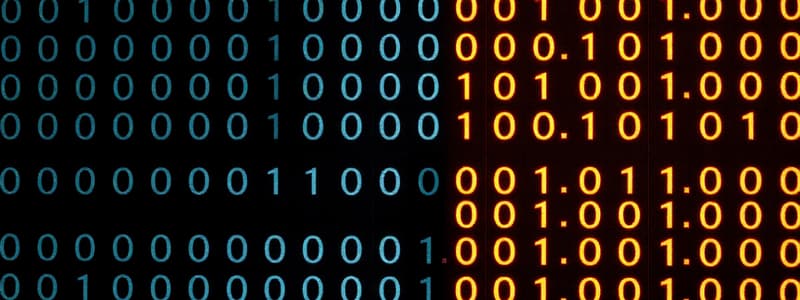Podcast
Questions and Answers
What does the hexadecimal color code #FF0000 represent?
What does the hexadecimal color code #FF0000 represent?
- Green color
- Yellow color
- Blue color
- Red color (correct)
What is the first step in converting binary to hexadecimal?
What is the first step in converting binary to hexadecimal?
- Convert hexadecimal to base-10
- Directly express binary as hex
- Convert each binary digit to decimal
- Group bits in fours (correct)
When converting hexadecimal to binary, how many bits does each hex character represent?
When converting hexadecimal to binary, how many bits does each hex character represent?
- 3 bits
- 4 bits (correct)
- 6 bits
- 2 bits
Why is attention to detail critical during conversions between number systems?
Why is attention to detail critical during conversions between number systems?
Which bases are used in binary and hexadecimal systems respectively?
Which bases are used in binary and hexadecimal systems respectively?
What is the primary use of hexadecimal in computer science?
What is the primary use of hexadecimal in computer science?
When converting the binary number 100101 to hexadecimal, what must you do with the last group of bits?
When converting the binary number 100101 to hexadecimal, what must you do with the last group of bits?
What is the binary equivalent of the hexadecimal digit F?
What is the binary equivalent of the hexadecimal digit F?
What is the result of converting the hexadecimal number 2A to binary?
What is the result of converting the hexadecimal number 2A to binary?
Why is it important to pad with leading zeros in binary to hexadecimal conversions?
Why is it important to pad with leading zeros in binary to hexadecimal conversions?
How many symbols are used in the hexadecimal number system?
How many symbols are used in the hexadecimal number system?
In binary, the group 1101 corresponds to which hexadecimal digit?
In binary, the group 1101 corresponds to which hexadecimal digit?
What characteristic differentiates positional number systems like binary, octal, and hexadecimal?
What characteristic differentiates positional number systems like binary, octal, and hexadecimal?
Flashcards
Representing Colors
Representing Colors
A system of representing colors on digital screens, commonly seen in HTML with examples like '#FF0000' for red.
Computer Memory and Data Storage
Computer Memory and Data Storage
The way data is stored in computer memory and hard drives, using a combination of 0s and 1s.
Networking and Communication
Networking and Communication
Used in IP addresses and different network protocols to identify and communicate between devices.
Binary to Hex
Binary to Hex
Signup and view all the flashcards
Hex to Binary
Hex to Binary
Signup and view all the flashcards
Hexadecimal
Hexadecimal
Signup and view all the flashcards
Binary
Binary
Signup and view all the flashcards
Binary to Hexadecimal Conversion
Binary to Hexadecimal Conversion
Signup and view all the flashcards
Hexadecimal to Binary Conversion
Hexadecimal to Binary Conversion
Signup and view all the flashcards
Padding
Padding
Signup and view all the flashcards
Positional Number System
Positional Number System
Signup and view all the flashcards
Base or Radix
Base or Radix
Signup and view all the flashcards
Representation of Data
Representation of Data
Signup and view all the flashcards
Study Notes
Introduction to Hexadecimal and Binary Conversions
- Hexadecimal (hex) is a base-16 number system using 16 symbols (0-9 and A-F) to represent values.
- Binary is a base-2 number system using only two symbols (0 and 1).
- Conversion between these systems is crucial in computer science for representing data in memory, networking, and more.
Converting from Binary to Hexadecimal
- Group binary digits (bits) into groups of four. Add leading zeros to make groups of four if needed.
- Convert each group of four binary digits to its corresponding hexadecimal digit.
- Combine hexadecimal digits to form the hexadecimal representation of the original binary number.
Example: Binary to Hexadecimal Conversion
- Binary: 10110110101
- Grouping: 1011 0110 1010
- Conversion:
- 1011 = B
- 0110 = 6
- 1010 = A
- Hexadecimal: B6A
Converting from Hexadecimal to Binary
- Convert each hexadecimal digit to its four-bit binary equivalent.
- Combine binary digits to form the binary representation of the original hexadecimal number.
Example: Hexadecimal to Binary Conversion
- Hexadecimal: 3F2
- Conversion:
- 3 = 0011
- F = 1111
- 2 = 0010
- Binary: 001111110010
Important Considerations
- Padding: Ensure leading zeros for proper conversion from binary to hexadecimal.
- Error Prevention: Carefully convert each hex digit to its correct four-bit binary equivalent.
- Large Numbers: Conversion methods are applicable to numbers of any size. Efficient computational tools are useful for large quantities.
Base Conversion Overview
- Binary, octal, and hexadecimal systems are all positional systems; digits' values depend on their position relative to the radix point.
- The "base" or "radix" differentiates these systems; it defines the set of encoded values for each digit.
- Larger bases use fewer digits to represent large values; this is beneficial in computer systems where concise representation improves efficiency.
Studying That Suits You
Use AI to generate personalized quizzes and flashcards to suit your learning preferences.




